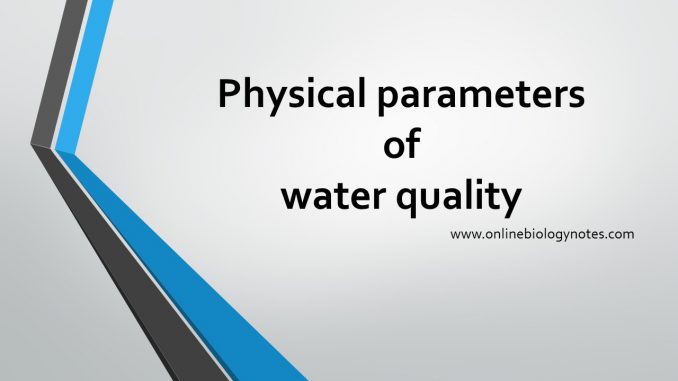
Physical parameters of water quality /Physical characteristic of water
- These are some physical aspects of water quality that helps to determine whether water is polluted or not.
1. Color:
- Pure water is colorless. Therefore any types of color appearance in water indicates water pollution.
- Natural water system is often colored by foreign material. If color is due to suspended material, it is called as apparent color. Color given by dissolved material that remains even after removal of suspended material is called true color or real color.
- The guideline value (maximum acceptable level) for color of drinking water is 15 TCU (True color unit).
2. Turbidity:
- Pure water is clear and do not absorb light. Therefore if turbidity appears in water, it indicates water pollution.
- Turbidity in water is given by various materials like suspended solid, dissolved materials and microbial loads. In general turbidity increases with increases in quantity of these materials in water. However different materials differ in their light absorption capacity.
- Some materials that give turbidity may be toxic to consumers. Therefore turbid water is not suitable for drinking purposes. Furthermore turbidity decrease efficiency of disinfection process.
- Materials that give turbidity provide attachment site for toxic chemicals.
- Turbidity prevents penetration of light into deeper layer of natural water system that directly affects photosynthetic organism in bottom.
- Drinking water should have turbidity less than 5 NTU (Naphthalometric turbidity unit)
3. Taste and odor:
- Pure water is always tasteless and odorless. Therefore if any types of taste and odor is present, it indicates water pollution.
- Water taste and odor may develops due to natural or artificial regions.
- Artificial region for taste and odor in water is due to disinfection process (chlorination). Some natural impurities dissolved in water can also give taste and odor.
- Inorganic salts such as NaCl, KCl etc dissolve in water give taste whereas compounds like H2S can give both taste and odor.
- Compounds giving taste and odor to water may be toxic to consumer, so drinking water should be taste less and odor less.
4. Temperature:
- Temperature is not directly used to evaluate whether water is potable (drinkable) or not.
- In natural water system like lake and river, temperature is very important physical factor that determines water quality. If temperature increase, solubility of Oxygen in water decreases.
- Furthermore rise in temperature increases the growth rate of aquatic microorganism, so they consume dissolved O2 faster and level of dissolved O2 decreases.
- Similarly, temperature affects disinfection process because efficiency of disinfection is lower at lower temperature.
5. Foam:
- Foam in water id due to foaming substances like detergents, soaps etc dissolve in water. Foam is regarded as dangerous in natural water system because it creates anaerobic condition.
- Some foaming substance is toxic to consumers. Therefore water with foam is not suitable for drinking purposes.
6. Conductivity:
- Conductivity of water is mainly due to presence of ionizable inorganic compounds.
- Pure water has very low conductance. For example 1µ mho for distilled water. Therefore conductivity measurement indicates amount of ionizable inorganic compounds in water.
7. Total dissolved solid:
- If water is filtered to remove suspended solid, the remaining solid in water indicates total dissolved solid.
- Dissolved solid may be organic (animal or plants waste) or inorganic compounds (carbonate, sulfate, bicarbonate etc). These compounds give variety of effects like hardness, taste, odor etc depending on nature of dissolved solid.
- If the dissolved solid in water exceeds 300 mg/ltr, it adversely affects living organisms as well as industrial products.
